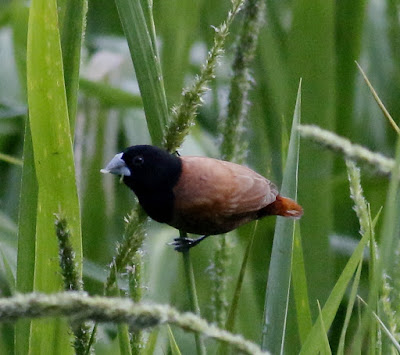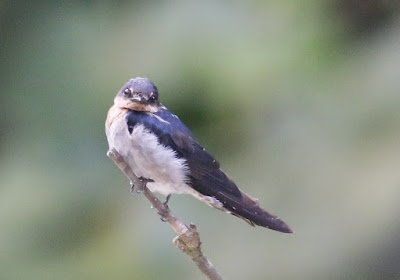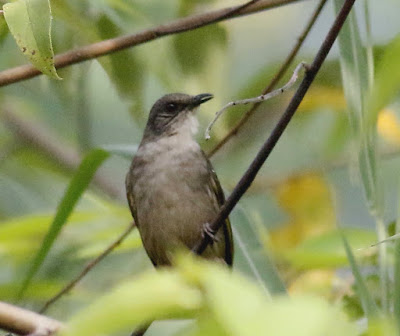Bird watching in your backyard usually does not produce many rarities but the common birds here can certainly give you some decent account of themselves. My 'backyard' birding was just a 15 minutes drive away from my home. Reached the site recently at about 6.55am, hoping to catch a glimpse of some nocturnal birds if possible. Well i actually did saw a nightjar flying from one thick foliage into another thicker foliage down the ravine. Can't really tell which species it belongs to except that it was a nightjar (i did caught a glimpse of its two white patches on its wings though).
In the early hours of the morning, things were a bit slow and quiet except for the sounds from some crickets and frogs which sounded like some ducks quacking. The birds were really not out from their siesta. As i was walking slowly along its trail, a brownish bird suddenly dashed across the trail. Heck! my heart did skipped a few beats as i reckoned it could have been a ferruginous babbler. So i stopped and waited for a moment hoping it would reappear or at least make some noise. The bird actually did reappear and it turned out to be a "Tiger Shrike".
 |
| Tiger Shrike |
The first few photos were blur. So i decided to use some light to ensure that it was a tiger shrike. It hunted the insect right down to the ground as depicted from the above photo.
This was a record shot of the tiger shrike. From its size and its brownish color, it can put you in the spot if you don't identify it correctly.
The next bird you will see would surely make you freeze for awhile.
In poor light every bird would look like a mega lifer especially with such pose.
Before your imagination runs wild like mine, let us first see what the field guides / books have to say. If you are familiar with "The Handbook of the Birds of the World" which i believe uses del Hoyo's classification and Clement's checklist, this old world flycatcher has been divided into several subspecies:
i) Muscicapa dauurica dauurica - non -breeding in S.E.A
ii) M. d. poonensis
iii) M. d. williamsoni - breeds in Peninsular Malaysia
iv) M. d. siamensis
Dr Wells (1982) recently added another subspecies i.e M.d umbrosa which supposedly only occurs in Borneo. The classification of the above subspecies apparently were mainly hypothesized from the differences in their breeding grounds and not so much on their morphological characteristics. Who knows there may be a superfamily or supersubspecies be created in the near future should their breeding ground overlaps. Nevertheless, according to Allen.J & Pearson (2012) field guide, M.d Williamsoni has a tinge of rufescent on its upper tail. From the second photo above, you could see there was a tinge of rufescent on its upper tail. Hence i believe that the above Asian Brown Flycatcher is most likely a W. d. Williamsoni which is reportedly to be less common than W. d. dauurica.
Now how about this Asian Brown Flycatcher which was also seen nearby?
Looks more like the common M.d. dauurica with its whitish underparts.
Lurking nearby was this Tickell's Blue flycatcher
 |
| Tickell's Blue Flycatcher |
This flycatcher was located from its usual calls which ends with a "tuck". This is most likely a female Tickell's Blue.
 |
| Eastern Crowned Warbler |
You do not need to bring out your field guides or scratch your head on this warbler. It has a crown stripe shown on another photo but unfortunately the photo was not publication worthy.
Now you can relax a bit as the next few birds are as common as your dandelions.
 |
| Greater Racket-Tailed Drongo |
It looks like it has a butterfly or a swallow attach to its extensions.
This is a pair of Little Green Pigeon (Treron olax)
A half asleep young Pacific Swallow.
A fast asleep Stripped-Throated Bulbul. Probably did some
odd jobs the night before.
odd jobs the night before.
A pair of Olive-Winged Bulbul.
 |
| Chestnut Munia |
 |
| Ruby-cheeked Sunbird (male) |
 |
| Orange-Bellied Flowerpecker (male) |
Long body shape, notch tail and pointed wings = Germain Swiflet?
 |
| Ashy Minivet (male) |
This was only the second time i have seen a male Ashy Minivet.
 |
| Ashy Minivet (female) |
A female Ashy Minivet from the back.
This Asian Paradise Flycatcher was playing peek-a-boo with me.
A look from the back of an Asian Paradise Flycatcher
Black-Winged Flycatcher Shrike
So there you go - a host of common winter visitors and local common birds for your viewing pleasure. Hope you have enjoyed viewing the common backyard birds as much as i have enjoyed showing their photos.






































































